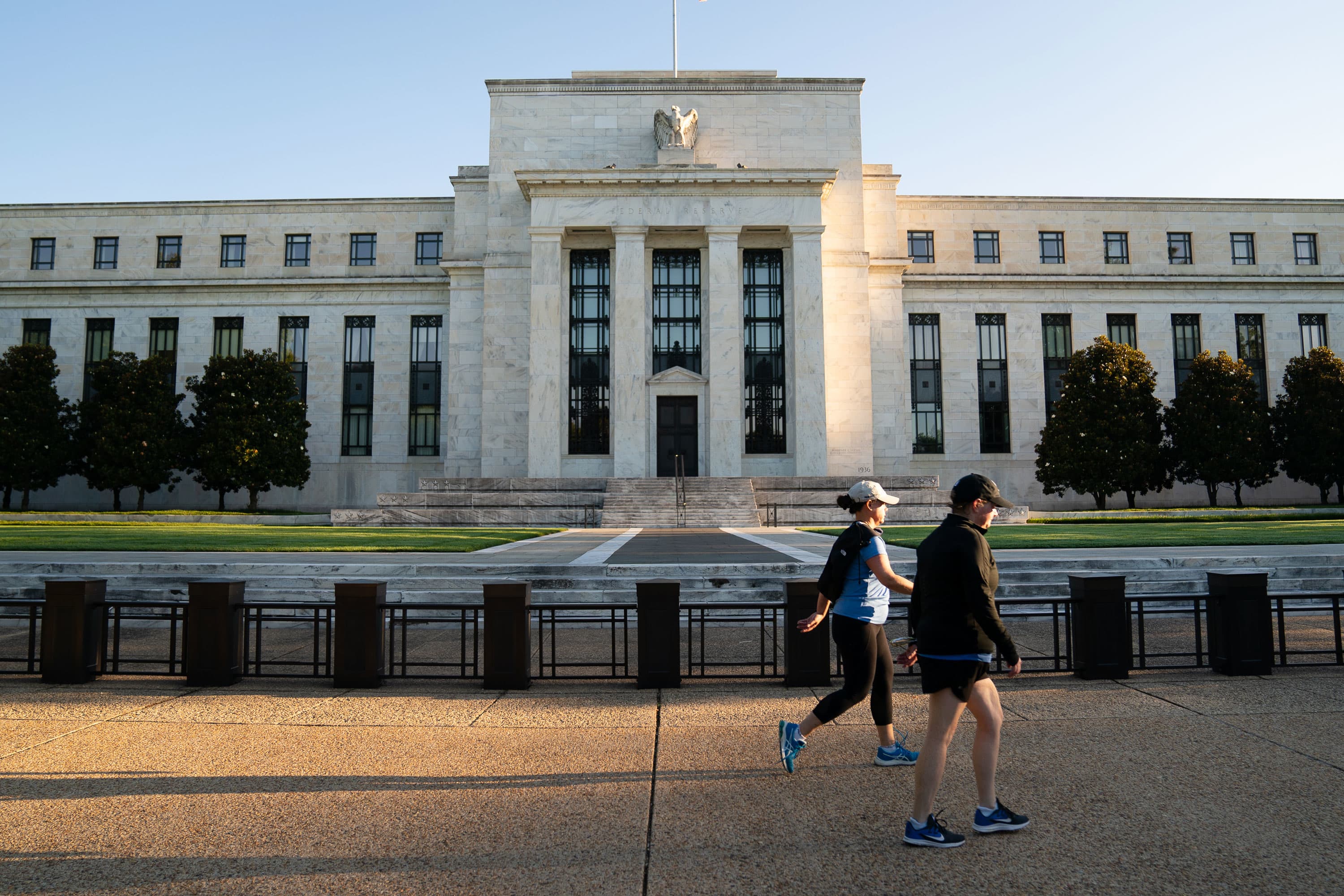Joggers pass the Marriner S. Eccles Federal Reserve building in Washington, D.C., on Tuesday, Aug. 18, 2020.
Erin Scott | Bloomberg | Getty Images
With inflation still elusive and a host of questions surrounding an economy that just set a single-quarter record for growth, the Federal Reserve faces a choice of whether to wait for conditions to unfold further, or act now to provide some extra help.
Most market participants expect the Federal Open Market Committee to sit on its hands when it holds its policy meeting Tuesday and Wednesday.
However, officials are expected to discuss the policy options open to them at this point, and with so much uncertainty surrounding the current situation it wouldn’t be that big of a surprise to see them make some kind of move.
“I just don’t see the benefits of waiting until December,” said Aneta Markowska, chief financial economist at Jefferies. “A lot has changed in the past two weeks. Almost all the worries they flagged in September have materialized or are in the process of materializing. So they don’t have the luxury of time anymore.”
That sense of urgency sounds incongruous with an economy that just recorded a 33.1% annualized GDP gain in the third quarter and one that has restored 11.4 million jobs since May and is in the midst of a housing boom.
However, economists at the Fed and elsewhere worry that the best of the gains are behind while the major tailwind of government stimulus funding has dried up. Rising coronavirus cases are sparking worries of renewed economic pressure as communities face pressure to reinstitute restrictions on businesses.
And the Fed’s got another problem on its hands: a market that doesn’t necessarily believe in the central bank’s recently adopted effort to push inflation higher and promise not to raise interest rates until that goals is met.
Inflation expectations, according to market indicators, actually have edged lower since the Fed approved an approach in which it will let inflation run above its 2% goal after periods, like much of the past decade, where it has fallen below that level. In the past, the Fed had used falling unemployment as a pre-emptive signal to raise rates to stave off inflation, something it will no longer do.
A Commerce Department report Friday indicated that headline inflation, under the Fed’s preferred gauge, nudged up to 1.4% for September, still well below the central bank’s desired pace.
“The market just wanted more follow-through and obviously hasn’t gotten it,” Markowska said. “In September, maybe they felt like there was no urgency to do anything immediately. What has changed between then and now is the urgency has increased.”
A change to Main Street
In fact, the Fed already has taken one additional measure that the market had been watching out for.
The Fed announced Friday it was easing some of the conditions around its Main Street Lending Program for small- and medium-sized businesses. The central bank slashed the minimum loan to $100,000 from $250,000 and eased the debt restrictions for applicants.
Beyond that, policymakers have a diminishing number of options that Fed officials themselves have expressed varying levels of doubt over.
“If a severe winter virus resurgence proved more economically damaging than we expect and the FOMC wanted to respond, its options would be limited,” Goldman Sachs economist David Mericle said in a note. “The most likely response would be to adjust the composition or pace of asset purchases, but Fed officials have expressed only lukewarm support for such a move because they see it as unlikely to be particularly effective.”
Indeed, market participants widely expect the Fed’s next move would be to alter its asset purchasing program. The Fed is buying a minimum of $120 billion a month in Treasurys and mortgage-backed securities, and it could change the composition of those purchases to achieve various ends.
For one, it could simply expand the level it is buying. It also could extend the duration of the bonds to influence yields further out on the curve. Finally, the Fed can continue to alter the language it uses to frame the goals of the purchases, from facilitating market functioning to broader support of the economy.
“For the time being, we think there is little more the Fed will do, but [Chairman Jerome] Powell will likely reiterate that it is willing to do what is necessary to provide support to the economic backdrop,” economists at RBC Capital Markets said in a note.
“While we don’t expect the Committee to make any changes at this meeting, if the early days of the virus are any indication, we do expect the Fed would not hesitate to act swiftly if case counts rise to such an extent that state governments start closing down sectors of the economy,” they added.
The Fed will be watching financial conditions closely in the coming days, and its meeting will conclude a day after a presidential election whose results could provide direction for how aggressive the fiscal stimulus might be.
The recent stock market decline is one thing officials will pay attention to, as is tightening in lending standards as well as the pressure put on consumers from a potential virus-induced economic slowdown.
While the committee may choose not to address those items specifically in its post-meeting statement Powell will get a chance in his press conference afterwards.
